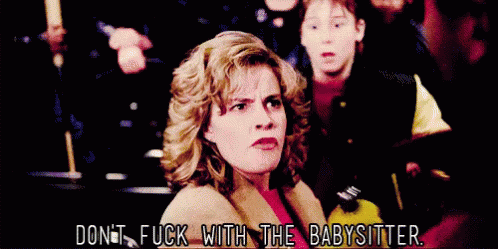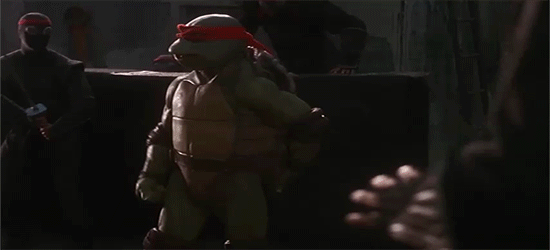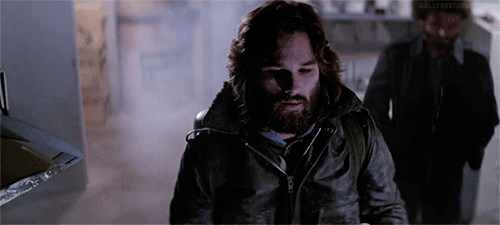It’s my birthday, and I decided to do something a little different, so I put together a list of formative movies from my misspent childhood. Not all of these are even good, but they’ve all impacted me one way or another (.gif sources listed where I could find them):

(credit: Maudit)
1. Mr. Mom (1983, dir. Stan Dragoti): apparently watched this a ton when I was little. Would even crash carts into others at the grocery store and say “I have right of way”–I was a little shit. Superficially, it’s a movie about realigned masculinity (Michael Keaton learning to parent, etc.), the decline of the Big Three and the American industrial sector/organized labor, Reaganomics and all that. John Hughes, who wrote the script, doesn’t seem to particularly care about any of that, though, beyond as a vehicle for delivering jokes, most of which is forgettable. Keaton is what really makes this worth watching. The rest of the cast is ‘eh’–Terri Garr and Christopher Lloyd are wasted, everybody else is static –but Keaton is perfect. Right in that range of having a comedic bite to a guy who, objectively, is being a shitty person, and is charismatic enough to make him likeable enough you want him to become better…so when he does you actually give a shit. Oh, and he punches Martin Mull, and who HASN’T wanted to do that?

(credit: Misan[trope]y)
2. Godzilla vs. The Sea Monster (or Ebirah, Horror of the Deep if you want the original title) (1966, dir. Jun Fukuda): My gateway into Godzilla specifically, Toho monster movies and Japanese cinema generally. Also a King Kong script, repurposed when Toho lost the license (Godzilla, for instance, is infatuated with the lone woman in the group). Jun Fukuda also isn’t half the director of Ishiro Honda: sets and costumes are noticeably cheaper, and original monsters (a giant lobster and condor) are boring. He does, however, hone in on a childish sense of adventure (spies! thieves on the lam! teenagers at dance-offs!) and shocking levels of monster violence. So, in that regard, it was perfect for someone watching a movie in pre-K, when one of the other kids brought in a VHS.

(credit: unknown)
3. Cobra (1986, dir. George P. Cosmatos): Sylvester Stallone’s Beverly Hills Cop is full of ridiculous, future shock snarling and violence, coupled with weird little character bits (cutting pizza with scissors and the matchstick). Everybody in it is delirious and sweaty and so very 80s. What’s not to love about this movie?

(credit: unknown)
4. Adventures in Babysitting (1987, dir. Chris Columbus): Probably the first “one crazy night” movie I remember watching, a genre I’ve only become more fond of. Even the bad ones have an economy of storytelling to them which makes it hard to absolutely hate them, because you aren’t forced to either leave or sit through 3 hours of it (superhero movies, I’m looking at you). And Adventures is the good kind of one crazy night: a fun cast of archetypes given a simple goal, complicated by increasingly insane obstacles. What starts as a simple jaunt into the city to pick up a friend becomes a life or death chase from mobsters, climaxing with a small child clinging for dear life on the side of a glass and steel skyscraper. Also manages to, on the side, make a really great blues musical number.

(credit: unknown)
5. Blade (1998, dir. Stephen Norrington): Speaking of superhero movies, I can space my viewing of Blade out by years, and still recite it almost line for line. Can’t even remember any of the Marvel movies minutes after seeing them, which should say everything. Before anyone chimes in with “nostalgia goggles” or whatever bullshit, I’m going to say this: most great movies are built around a single, strong idea. Blade does this so well, and most other entries in this genre are so bad at it, that it almost boggles the mind it did it before the genre went big, did it well, and yet no one bothered to replicate it. That that single idea–of a nigh-unstoppable, impossibly cool, angry, nihilistic half-vampire commando’s unceasing quest to purge the world of bloodsuckers–invariably centers around star Wesley Snipes might be the answer why. Snipes’ physique and face (perpetually behind those badass shades) dominate the screen. His voice commands attention. He’s buffered by capable character actors and a no-bullshit script from David Goyer, but it’s unquestionably his show. This is a movie with a star and it lets you know it–Avengers has Robert Downey Jr., but the sarcastic wit he brought has been exaggerated, then sublimated into Whedon dialogue and so much franchise noise (and who else do they have? Chris Evans? Fuck off). Blade gives you this solid image, every mannerism and one-liner etched in marble. In a genre built on perpetual, ephemeral hype, it gives you something eternal.

(credit: The Fanboy Perspective)
6. Teenage Mutant Ninja Turtles (1990, dir. Steve Barron): There’s a lot I could say about this movie, but most importantly it doesn’t talk down to its audience. It juggles some goofy, cartoon hijinks and family friendly moralizing, but is also a movie about disaffected youth, the effects of violence on bodies, and about the very human need for healthy social attachments, but is surprisingly subtle about this. Like, the most ham-fisted this movie gets is when Splinter sagely intones about fatherhood or shouts at the Foot Clan kids about the Shredder exploiting them (and the movie earns that shit, so it doesn’t feel ham-fisted). Dialogue elsewhere is watching these characters bond and converse, either confronting or dancing around their conflicts (both external and internal), without anyone ever telling you exactly what they’re doing. Absolute favorite part remains the truck-start scene between Donatello and Casey Jones, which is just a gag-heavy version of literally any Michael Mann scene: it establishes the way those characters relate to each other and their playful antagonism, but it’s layered into a scene that is: a) the two of them fixing a beat-up old truck, b) having a fannish, “who would marry who” conversation about Gilligan’s Island, and c) playing a game where they insult each other alphabetical order.

(credit: unknown)
7. Terminator 2: Judgment Day (1991, dir. James Cameron): Would watch this at a family friend’s house, sitting next to their dog while the adults played euchre or pinochle. It opens with Linda Hamilton narrating about the time-travel premise and the war against the machines, and then you see skulls getting crushed under a metal foot. Cameron just loads the movie with these arresting visuals, all while telling a story about a robot becoming the best dad possible in a world full of broken people. Even better: it’s a great showcase for Arnold Schwarzenegger, revisiting and reexamining his and Cameron’s iconic cyborg slasher as a portrait of emerging humanity. He sheds the sunglasses and motorcycle in tandem as he acquires expressions and slang from his charge, often repurposing in unintended ways like a dorky dad. Easily the best father/son movie of the 90s.

(credit: the c0smic s0rceress)
8. The Thing (1982, dir. John Carpenter): Best movie on this list, though it took me two viewings when I first encountered it to appreciate its genius. Quintessentially Carpenter in the way it depicts two kinds of collectives battling for supremacy: one a group of raggedy, burnt out men in over their heads on the edge of the world, a leader emerging in Kurt Russell’s indomitable, individualist MacReady; the other a walking, seething viral infection with a hive-mind mentality patterned after a rapist’s. That it’s also one of the great special effects movies, and a big-budget studio movie built entirely on a mounting, inescapable sense of dread is just icing on the cake.

(credit: unknown)
9. Robocop (1987, dir. Paul Verhoeven): Still can’t believe my parents let me watch this as a kid. Shockingly violent, even (more) today, and increasingly, frighteningly relevant. A biting satire, a rumination on the effects of mechanization on humanity, a religious metaphor, a science fiction film about Theseus’ paradox, a damn good action movie, Robocop is a movie that’s all of those things and none of them. Every time I sit down and watch it, every time I discuss it with anyone, I pick up something new. The one constant though, the thing which stuck with me, whether it was when I had the simple, childish, reptilian brain glee of watching Alex Murphy get back at the gangsters who executed him or now that I’ve been thinking about that movie for over 25 years: it’s Peter Wellers’ face, the contorted pain he exhibits in Murphy’s death. It is utter pain, in response to both the physical sensation of gunfire and the cruelty of Boddicker’s gang (acting, itself, as an extension of the corporate machine which infects its fictionalized Detroit). In a very real way, that movie instilled in me from an early age both a value for human life, and a respect for how easily it can be taken away.
Here’s to another year of being alive. Take care out there.
